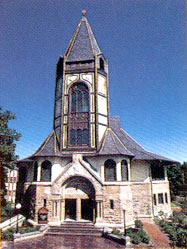
Fisk University
Fisk Free Colored School, predecessor of Fisk University, was established on January 9, 1866, in Nashville to offer education–as a means of building better lives–to formerly enslaved African Americans.
African Americans, both slave and free, exhibited two related overriding concerns during the antebellum and Civil War period: a passion for religion and a desire for education. Prior to 1856 in Nashville, these needs were met as blacks attended white churches or one of the eight priority (subscription) schools established for free blacks (though often attended by slaves). The racial fears preceding the Civil War produced an 1856 city ordinance prohibiting the education of all African Americans; the schools remained closed for more than a decade.
During the Civil War, the Union army emancipated African American slaves on its southward march. In February 1862 General Clinton Bowen Fisk (1828-1890) arrived with the Union forces occupying Nashville. One of the many Union soldiers and chaplains who became committed to instructing former slaves, Fisk exerted a lasting beneficial influence over the black community.
In 1865 Congress established the Freedmen’s Bureau to provide federal assistance in education and health care for emancipated African Americans. John Ogden, superintendent of education of the Freedmen’s Bureau in Tennessee, arrived at the bureau’s Nashville headquarters in 1865 to begin his duties. The Reverend Edward P. Smith, district secretary of the Middle West Department of the American Missionary Association, and the Reverend Erastus M. Cravath, who became the first secretary of the American Missionary Society, met with Ogden and agreed that Nashville was a suitable site for a normal school for African Americans. In late 1865 the organizers purchased a site on the fringe of downtown Nashville, and General Fisk used his influence to secure the former Union army hospital barracks to house the school.
Following dedication ceremonies on January 9, 1866, hundreds of former slaves of all ages flocked to enroll in Fisk School. Enrollment jumped from two hundred in February 1866 to nine hundred students by May of that year, a visible demonstration of the eagerness of local African Americans for knowledge. The first students received instruction in the primary subjects of alphabet, lettering, and counting. Four months after the school opened, the first educational audit revealed that over two hundred Fisk students could read.
In the fall of 1867 the Tennessee General Assembly passed enabling legislation for the state’s free public education. The law created a new demand for qualified teachers, especially African American teachers. To meet this demand, Fisk School refocused its mission from primary to higher education, and on August 22, 1867, Fisk Free Colored School was incorporated as Fisk University.
By 1871 the decay of the school’s buildings (former army barracks) and the rising enrollment presented an urgent need for a larger campus. With possible closure looming in the near future, the student choir embarked upon a fund-raising concert tour to save Fisk University. The nine-member ensemble gained fame as the Fisk Jubilee Singers while introducing the world to the melodious Negro spiritual as a musical art form. After a year-long concert tour of Europe, the Jubilee Singers returned to Nashville in May 1874, having raised nearly fifty thousand dollars for construction of a new building–to be christened Jubilee Hall–on the new Fisk University campus.
An active building program in the 1880s enhanced the university’s reputation, as did the well-educated graduates emerging from the school. In the 1890s the school’s curriculum expanded to include liberal arts, theology, advanced training for teachers, and a secondary school. As the new century dawned, the second generation of freed blacks enrolled at Fisk University, and the school underwent further changes, including the addition of African Americans to faculty and administrative staffs. After World War I, the enrollment of former servicemen and the African American cultural renaissance of the 1920s and 1930s further infused a spirit of black pride and independence into the student body. In 1947 Charles S. Johnson became the first African American president of Fisk University.
In 1955 the first dramatic manifestation of a modern revolution unfolded in the nonviolent protest against racial segregation in Montgomery, Alabama, and college students throughout the South began to build upon this new civil rights foundation. Fisk students trained in nonviolent-protest workshops and joined others in the South in staging the first student sit-in protests in November 1959. The sit-in movement continued during 1960 and involved more than one hundred cities across the South, as the student movement ushered in a decade of activism.
Over the next two and a half decades Fisk University eagerly moved forward through campus expansion, historic structure restoration and modernization, accelerated construction of new facilities, and amplified faculty credentials and professional development. Now, on the threshold of the twenty-first century, Fisk University remains committed to its historic mission to train its students for service to humanity. As in the past, excellence remains the university’s motivation and aspiration, assuring that Fisk University is not measured against a standard of “Negro education” but against the standard of American education at its best.
Suggested Reading
Reavis L. Mitchell Jr., Fisk University Since 1866: Thy Loyal Children Make Their Way (1995)



